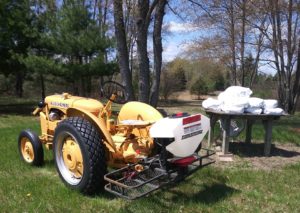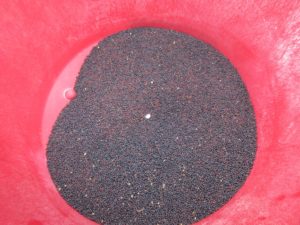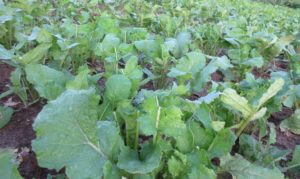Food Plot Basics
By Glen Wunderlich
Charter Member Professional Outdoor Media Association
Attracting and holding wildlife requires a few basic ingredients: food, cover, and water. Fortunately, most Michigan deer hunters have little trouble locating habitat that produces at least one of these necessities, and therefore, whitetail deer. However, if one wants an edge, food plots can tip the scales. In the process of establishing these magnetic environments, things don’t always go as planned.
To minimize the use of herbicides is a worthy goal for many reasons; to do so takes work. Herbicides, such as glyphosate, have the ability to cut time afield, as opposed to tilling repeatedly from spring to planting time in August for fall food plots. Applying only one spray before planting would mean I’d have to count on my 72 year-old Ford 8n tractor to do its part.
The work began in early spring before the weeds were able to fight back. The old tractor has a weak battery that should have been replaced long ago, but my innate cheapness coaxes it to cooperate with the assistance of a trickle charger. Two of the tires need a shot of air. Check, check.
Out to the field where the 6-foot disk harrow would chop, cut, and pummel the weeds into oblivion – at least for a little while. The process would be repeated numerous times through spring and summer before the weeds gained an upper hand. Along the way, fertilizer and lime were broadcast

1956 Allis Chalmers IB with rigged spreader
and allowed to break down well in advance of planting time.
Unfortunately, my ATV is temporarily out of commission, so I called on another old tractor to step up. My 1956 Allis Chalmers IB is an industrial tractor, not typically suited for field use, but I’d have to give it a go to keep on schedule. After all, it’s the only machine I have that can power the electric motor of the spreader with its 12-volt configuration. With a bit of redneck engineering, it worked as planned – not counting the soft soil where the turf tires almost failed to plod through.
To seed the first part of August means a certain amount of management is in order to pull it off.

A look at turnip seed inside the hand spreader
One last disk operation in July followed by some finer grooming with drag implements made to “fit” the field were successful.
Then, it was time to wait for the weeds to germinate, so they could be zapped with the glyphosate. The idea was to get the field as “clean” as possible. Again, the old Allis was rigged with a sprayer sitting atop a carrier attached to the receiver. To make the sprayer fan out properly, it had to be at the correct height. Success was gained again and the job was complete on August 1st.
Once the spray was dry, I became the motor for a broadcast seed spreader strapped onto my shoulders and walked the plots and cranked the handle. Then, before the pending rain washed out our plans, my pal, Joe, pulled an 8-foot cultipacker behind the old Ford and pushed the seed into the soil.
The timing couldn’t have been better, as Mother Nature pitched in with the missing ingredient: rain. Although we’ve had some hot and dry weather since, enough of the precious liquid from above has made this attempt at farming a success, as evidenced by the healthy brassicas. Believe it or not, the seed had begun germinating in less than 48 hours and nothing will stop it now – except those nibbling deer. But, that’s the whole idea.

Brassica foliage trimmed by deer. Plants less than one month old.






